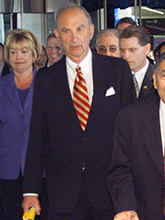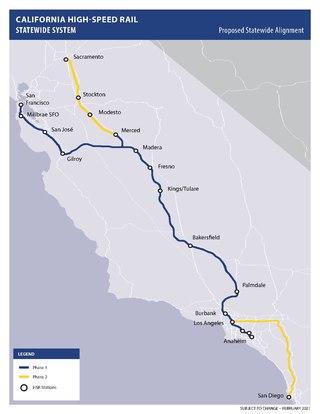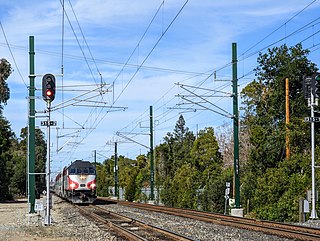
The Deutsche Bahn AG is the national railway company of Germany, and a state-owned enterprise under the control of the German government. Headquartered in the Bahntower in Berlin, it is a joint-stock company (AG) and the largest railway company in the world.

The Los Angeles County Metropolitan Transportation Authority (LACMTA), branded as Metro, is the county agency that plans, operates, and coordinates funding for most of the public transportation system in Los Angeles County, California, the most populated county in the United States, and the largest public transit agency in the county as well.

The San Joaquins is a passenger train service operated by Amtrak in California's San Joaquin Valley. Six daily round trips run between its southern terminus at Bakersfield and Stockton, with onward service to Sacramento and Oakland.

The Santa Clara Valley Transportation Authority, more commonly known simply as the Valley Transportation Authority (VTA), is a special district responsible for public transit services, congestion management, specific highway improvement projects, and countywide transportation planning for Santa Clara County, California. It serves San Jose, California, and the surrounding Silicon Valley. It is one of the governing parties for the Caltrain commuter rail line that serves the county. In 2023, the VTA's public transportation services had a combined ridership of 26,610,000, or about 87,500 per weekday as of the fourth quarter of 2023.

Fiona Ma is an American accountant and politician. She has been serving as the California state treasurer since January 7, 2019. She previously served as a member of the California Board of Equalization (2015–2019), the California State Assembly (2006–2012), and the San Francisco Board of Supervisors (2002–2006).

California High-Speed Rail (CAHSR) is a publicly funded high-speed rail system being developed in California by the California High-Speed Rail Authority. Phase 1, about 494 miles (795 km) long, is planned to run from San Francisco to Los Angeles and Anaheim via the Central Valley, and is partially funded and under construction. A proposed Phase 2 would extend the system north to Sacramento and south to San Diego, for a total of 776 miles (1,249 km). The project was authorized by a 2008 statewide ballot to connect the state's major urban areas and reduce intercity travel times. Phase 1 targets a travel time of 2 hours and 40 minutes from San Francisco to Los Angeles, compared to about nine hours on existing Amtrak service.

Quentin Lewis Kopp is an American attorney, politician and jurist. He served as a member of the San Francisco Board of Supervisors and in the California State Senate. Kopp ran unsuccessfully for mayor of San Francisco in 1979 against Dianne Feinstein. Kopp advocated for the extension of BART to SFO which was completed in 2003.

Plans for high-speed rail in the United States date back to the High-Speed Ground Transportation Act of 1965. Various state and federal proposals have followed. Despite being one of the world's first countries to get high-speed trains, it failed to spread. Definitions of what constitutes high-speed rail vary, including a range of speeds over 110 mph (180 km/h) and dedicated rail lines. Inter-city rail with top speeds between 90 and 125 mph is sometimes referred to in the United States as higher-speed rail.

Merced station is an intercity rail station located in Merced, California, United States. The station is served by seven daily round trips of the San Joaquins and is a transfer point between trains and Yosemite Area Regional Transportation System (YARTS) buses serving Yosemite National Park. Merced station has side platforms adjacent to the tracks of the BNSF Railway Stockton Subdivision.
Brightline West is a privately run high-speed rail route, currently under construction, to link the Las Vegas Valley and Rancho Cucamonga in the Greater Los Angeles area through the California high desert. The line will connect with existing rail at Rancho Cucamonga station of Metrolink's San Bernardino Line, a commuter rail line in Southern California. The project is intended to provide an alternative to air and automobile travel between Southern California and Las Vegas, a popular leisure destination. In December 2023, the United States Department of Transportation awarded Brightline West a $3 billion grant as part of the Infrastructure Investment and Jobs Act. Construction, initially expected to begin shortly after the grant was announced in 2023, began on April 22, 2024. Revenue service is planned to start in 2028.

Laura Friedman is an American former film producer and politician serving in the California State Assembly and a candidate for California's 30th congressional district. A Democrat, she represents the 44th Assembly district, encompassing the cities of Glendale, Burbank, the unincorporated community of La Crescenta-Montrose, and northern portions of Los Angeles, including Sunland-Tujunga, Shadow Hills, Lake View Terrace, La Tuna Canyon, Toluca Lake, Valley Village, Studio City and Sherman Oaks.

The California State Transportation Agency (CalSTA) is a state cabinet-level agency with the government of California. The agency is responsible for transportation-related departments within the state. The agency was created under governor Jerry Brown in 2013 after the previous Business, Transportation and Housing Agency's portfolio underwent reorganization.

The construction of the California High-Speed Rail system is an undertaking by the California High-Speed Rail Authority. The project is expected to span about 800 miles (1,300 km) and will be completed in two phases:

The California High-Speed Rail Authority was established in 1996 after decades of advocacy for building a high speed rail system in California. The passage of Proposition 1A in 2008, followed by the awarding of federal stimulus funds in 2010, established the initial funding for the California High-Speed Rail system. Construction contracts began to be awarded in 2013, and the groundbreaking ceremony for initial construction was held on January 6, 2015.
Merced station is a proposed California High-Speed Rail station in Merced, California, located in Downtown Merced. The environmentally approved site is on Martin Luther King Jr. Way near the interchange with Route 99/59, placing it about 7 blocks south from the existing Merced Amtrak station. The station was initially intended to be the northern terminus of the system's Initial Construction Segment. As of April 2022 the California High-Speed Rail Authority is studying an alternative location proposed by the City of Merced and other stakeholders, 8 blocks to the west-northwest along 15th Street, between O Street and R Street. The high-speed rail line will run on the south side of the Union Pacific Railroad right-of-way at these locations.

The California High-Speed Rail system will be built in two major phases. Phase I, about 520 miles (840 km) long using high-speed rail through the Central Valley, will connect San Francisco to Los Angeles. In Phase 2, the route will be extended in the Central Valley north to Sacramento, and from east through the Inland Empire and then south to San Diego. The total system length will be about 800 miles (1,300 km) long. Phase 2 currently has no timeline for completion.

The Caltrain Modernization Program (CalMod), sometimes referred to as the Caltrain Electrification Project, is a $2.44 billion project that will add a positive train control (PTC) system and electrify the main line of the U.S. commuter railroad Caltrain, which serves cities in the San Francisco Peninsula and Silicon Valley, as well as transition from its current diesel-electric locomotive powered trains to electric multiple units (EMU). According to Caltrain, electrification of the tracks will allow it to improve service times via faster acceleration and shorter headways, reduce air pollution and noise, and facilitate a future railway tunnel into downtown San Francisco's Salesforce Transit Center, as diesel trains cannot serve underground stations.
The Downtown Rail Extension (DTX) is a planned second phase of the San Francisco Transbay Transit Center (TTC). When complete, it will extend the Caltrain Peninsula Corridor commuter rail line from its current northern terminus at 4th and King via a 1.3 mi (2.1 km) tunnel. The new terminus will be near the Financial District and will provide intermodal connections to BART, Muni, Transbay AC Transit buses, and long-distance buses. In addition, the California High Speed Rail Authority (CHSRA) plans to use DTX and the Caltrain-owned Peninsula Corridor for service on the CHSRA San Francisco–San Jose segment. Because DTX uses a long tunnel, current diesel locomotives are not suitable and the Caltrain Modernization Project (CalMod), which includes electrification of the line and acquisition of electrified rolling stock, is a prerequisite.

Valley Link is a proposed 26-mile-long (42 km) commuter rail service in Northern California, which seeks to connect the rapid transit Bay Area Rapid Transit (BART) system in the San Francisco Bay Area with the northern San Joaquin Valley via the Tri-Valley region. Since 1997, BART's Blue Line's eastern terminus is at Dublin/Pleasanton station on the border of Dublin and Pleasanton. Valley Link seeks to extend rail service east from here into the northern San Joaquin Valley over Altamont Pass and to help alleviate traffic congestion and reducing greenhouse gas emissions on Interstate 580 (I-580). The project resulted from various failed proposals to extend the Blue Line east to Livermore.

In addition to the direct reduction in travel times the HSR project will produce, there are also economic and environmental impacts of the high-speed rail system. These were also specifically noted in Proposition 1A at the time the project sought authorization from the voters of the state in 2008. The anticipated benefits apply both generally to the state overall, as well as to the regions the train will pass through, and to the areas immediately around the train stations.



















